Supply Chain
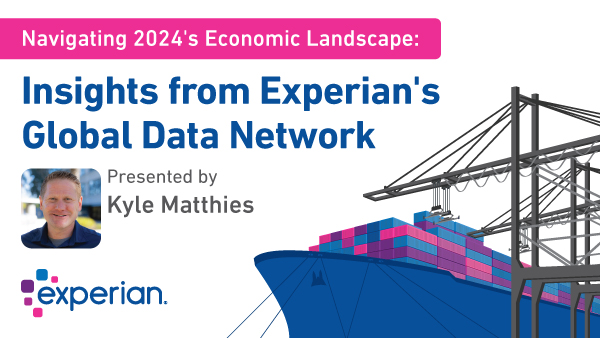
Experian's Kyle Matthies provides a roundup of international credit report usage statistics showing which regions are surging or declining.
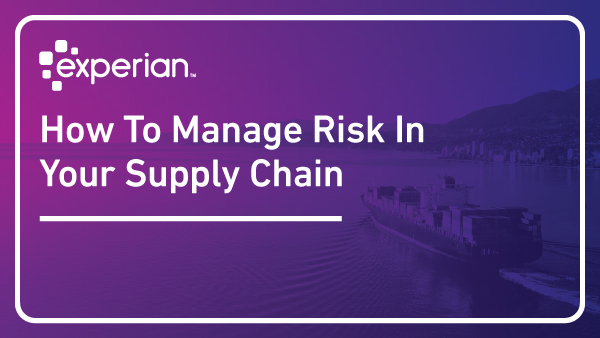
Images of giant container ships clogging up ports have become the public face of global supply chains' disruptions. With widespread factory and shipping operations interruptions, supplier delivery times increased dramatically. According to U.S. Census, 38.8 percent of small businesses experienced domestic supplier delays during the pandemic. Some even predict that global supply chain disruptions could continue into next year. While some aspects of the supply chain—such as increased consumer demand and labor shortages—are out of your hands, there are risks within your supply chain that you can manage and build resiliency and agility. Running a tight supplier network gives you a competitive advantage during periods of crisis when others are struggling to keep up. What is Supplier Risk Management? Supplier risk management is the process of evaluating your suppliers to understand better where the vulnerabilities lie and then taking proactive steps to mitigate the risks you've identified. In the past, many client companies overlooked their suppliers' health and operational resiliency. If one supplier faltered, another supplier could be counted on to step in and take their place. But it's not always simple. As the global pandemic has revealed, there can be challenges to finding alternative suppliers if demand soars. Whether it's geopolitical risks, natural disasters or labor unrest, many risks can impact the operational health of the entire supply chain. One supplier slip-up can throw off the whole chain and put a business in jeopardy. Client companies need to know how stable their suppliers are—not just today, but in the foreseeable future too. Companies need to manage their supplier networks proactively. Common Supplier Risks Assessing the health of the entire supply chain is more critical than ever. Put these common supplier risks on your radar. Social, Ethical or Environmental Risks Increasingly, businesses are screening their suppliers for how well they perform on environmental, social or governance (ESG) factors. Businesses want to ensure that they are working with vendors with a solid track record on sustainability, employee relationships and transparency. For example, working with suppliers that flout emissions standards or engage in bribery can pose liability risks for you. The negative reputations of these types of suppliers can carry over to their clients. Moreover, doing business with suppliers that are on government sanctions or non-compliance lists can result in penalties for you and potentially even legal liability. Even companies that profess a commitment to ESG principles must demonstrate adherence to certain standards within their supply chain. It's what consumers increasingly demand and some governments are legislating. But how can you screen suppliers to ensure compliance with ESG principles? Technology can help: Experian's partner Global Risk Management Solutions (GRMS) allows companies to keep track of all their suppliers and verifies compliance within the required Environmental, Social and Governance (ESG) parameters. How to Create a World-Class Supplier Risk Assessment Program To learn more about Global Risk Management Solutions watch our interview where we discuss the main points of setting up a world-class program. Financial Risks Many businesses monitor their suppliers for financial risks, which is the likelihood that a supplier will run into financial difficulty, and therefore, renege on their obligations. Working with a supplier on shaky financing footing can undermine the operational health of your organization. For example, suppliers in financial distress can suffer service interruptions, poor quality and safety problems – all of which can spill over to clients, especially if it's a main supplier. If one of your suppliers suddenly closes its doors or goes bankrupt, it may be difficult to find a replacement supplier on short notice. Screening for financial risks has become more straightforward, thanks to technological advancements. Tools like Experian's Small Business Financial Exchange and Supplier Check Reports provide information on small business credit performance to help you assess financial risks more efficiently. Operational Risks Any risk that results from flawed internal processes or management, rather than external events, is known as operational risk. This can include labor unrest, factory closures and equipment failures, which can ultimately prevent a supplier from meeting their deliverables. Understanding the potential and actual operational challenges faced by your suppliers can help you assess whether to work with them. Continuity Risks As the pandemic has shown, it's impossible to predict when a crisis might hit your supply chain. That's why businesses need to develop a continuity plan for how they'll handle unexpected crises and the steps they'll take for recovery. That's true of your suppliers too. Suppliers that lack continuity plans can easily get kicked off the line without a plan for a rebound. That can cause major disruptions to their clients. But how do you know what your suppliers' business continuity plans are? Strategic Risks Internal or external events that make it difficult or impossible for a company to achieve its business goals are strategic risks and you need to monitor your supply chain against them. For example, a supplier that may not have the resources to hire enough workers poses a strategic risk for its clients and can undermine its market position and reputation. Until recently, companies hadn't considered their supply chain as a strategic decision because of the siloed decision-making process. Bringing together supply chain functions with risk management and corporate strategy places supply chain management at the center of strategic planning and can build resiliency. Expanding the role of procurement within your organization can help management better assess the weak links, anticipate unexpected events and adapt to changing conditions. Insights drive awareness Managing your supply chain risk is only possible when you have insight and clarity into the financial health of your suppliers. Experian's powerful technology solutions allow you to do this in several ways: Finding alternative lookalike suppliers Your existing performing suppliers can be valuable in identifying other possible alternative or contingent suppliers. By leveraging tools like Experian's Business TargetIQ (BTIQ), you can effortlessly profile your ideal supplier with premier firmographic, geographic, risk and credit attributes. Once you have determined your ideal supplier profile, use the "find similar" feature to swiftly and easily identify other companies that meet your criteria and have similar profiles. Further expand your segment and qualify by adjusting the platform's robust built-in filters. In addition, third-party and other data can easily be uploaded to get a comprehensive 360-view of the suppliers. Why start from scratch when you can easily leverage existing relationships that are performing? Develop an Integrated Supplier Database Your ability to make informed decisions hinges on access to quality data about your suppliers. But getting reliable, real-time data on your own may be difficult. You may need to work with a third-party vendor that gathers and validates this information. But vast amounts of data can quickly overwhelm an organization, especially if it's siloed. For data to be useful, it must integrate with existing customer relationship management and enterprise resource planning software that your workforce uses each day. Integrating these databases offers a 360-degree view of your entire supply chain, which makes it easier to isolate risks. Look for vendors that can work with your legacy systems. Segment Suppliers into Risk Categories Segmenting suppliers by different attributes can provide valuable insights into how vital each supplier is to your operations. While there are several ways to segment suppliers – such as the amount of spend, product, service or volume – consider segmenting suppliers based on their risk profiles. This approach can uncover the level of risk exposure for each supplier, no matter how small. A risk event, even with a smaller supplier, can cause downstream disruptions. Translate Risk Data into Predictive Intelligence With vast amounts of data on suppliers, it's possible to create forecasting models to play out "what if" scenarios based on both historical information as well as real-time events. However, even the most powerful artificial intelligence programs are only as good as the quality of the data input. Quality data increases the probability of an accurate forecast and makes it meaningful. To tackle this, GRMS monitors suppliers in real-time and sends clients push notifications alerting them to any status changes. That way, they can act on potential problems before they hit their supply chain. Keep Supplier Assessments Up to Date While some companies may perform supplier assessments internally, it can be hard to continuously monitor them. For example, knowing when a supplier's insurance policy has lapsed or if regulatory actions have been taken against a supplier is crucial to building their risk profile. Companies without in-house expertise on supply chain risk factors should seek out third-party vendors that can gather, assess and monitor supplier data. Why is Supplier Risk Management Important? During difficult market conditions, a well-managed supplier network means having a leg up in the industry. Businesses that manage actual or potential risks may continue to operate without disruption, as well as gain important insights that can help turn risks into opportunities. They can also improve their competitive position and lower supplier costs. Information is power. On the flip side, companies that fail to adequately assess the supply chain risks can get blindsided. Here are a few reasons why supplier risk management is critical to business success. Greater Insights Help Create Strategies That Turn Risk into Competitive Advantages A supply chain is more than the building block of your business. It's what makes your business possible and is a revenue driver and a differentiator. A powerful, reliable supply chain enables you to get products and services to market faster and with lower costs than competitors. Case in point: according to Deloitte, 79 percent of organizations identified as "supply chain leaders" achieve revenue growth that is "significantly above-average." Disruptions anywhere along the supply chain can undermine those goals. According to that same report, only 8 percent of the organizations with "lower-performing supply chains" were able to achieve "above-average" revenue growth. The bottom line: with greater technology-enabled insights into your supplier network, you can turn risk into competitive advantages. For example, data insights can alert you if a major supplier faces financial difficulties, which gives you time to find a new, better-positioned alternative. Your competitors may not have access to such a resource, putting them at a disadvantage. An Improved Competitive Position in Your Market With shipping delays and poor customer service befalling businesses of all types in recent months, a well-managed supply chain can help you deliver greater value to customers compared to your competitors. According to a recent Oracle survey, 76 percent of people would trust and be more willing to buy from (78 percent) a company if they knew it used advanced technologies like artificial intelligence to manage its supply chain. By emphasizing supply chain risk management within your organization and creating processes to assess the risks, you can gain a competitive advantage in the industry. Lower Supplier Costs The cost of supply chain disruption is higher than you may think. Downtime, sourcing a new supplier and missed deliverables on your end can add up to astronomical amounts: on average, global supply chain disruptions cost $184 million per year in lost revenue for each large organization, according to Interos Annual Global Supply Chain Report. There are also long-term costs, such as reputational damage and customer perceptions, which are difficult to measure. In that same Interos report, 83 percent of responding organizations reported suffering "at least a little reputational damage" due to supply chain problems. Ultimately, a supply chain that delivers and allows you to keep your brand promises is worth its weight in gold. Reliable suppliers allow you to keep your overall costs in check. Proactive risk management of your supply chain is an essential cost containment best practice. Looking Ahead to the Future of Supply Chain Risk Management Some supply chain disruptions are out of your hands. But there are ways to intelligently and efficiently manage risks and bring stability to your company. Until now, it's been difficult for companies to assess and monitor the financial and operational health of their suppliers, either due to a lack of internal capacity or the necessary transparency. But that's changed: by utilizing robust technology solutions, organizations can minimize supply chain disruptions and optimize their strategic value.
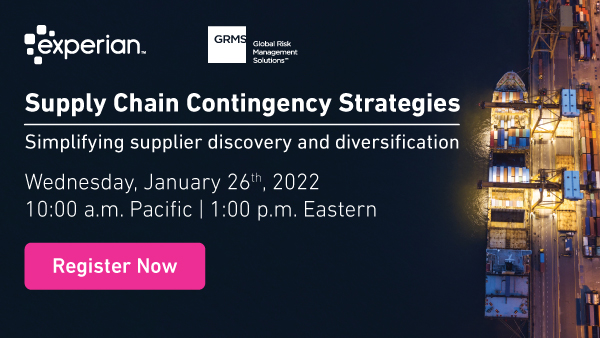
By all indications, the supply chain challenge of this year will stretch well into 2022. Risk managers and finance departments are working in real-time to pivot, and keep customers satisfied, and while there’s currently no silver bullet to port delays, the lack of truck drivers or warehouse space, there are new strategies to consider. Join us for a very special supplier management webinar. Will your current suppliers be capable of delivering or do you need to pivot? In our upcoming webinar our panel of experts will talk about simplifying supplier discovery and diversification. In this talk you will learn: How to conduct a world-class supplier risk assessment program How to identify look-a-like suppliers in specific industries How to filter on multiple risk factors and more We will also be taking your questions, it promises to be an illuminating discussion, we hope you can join us. Register for Webinar
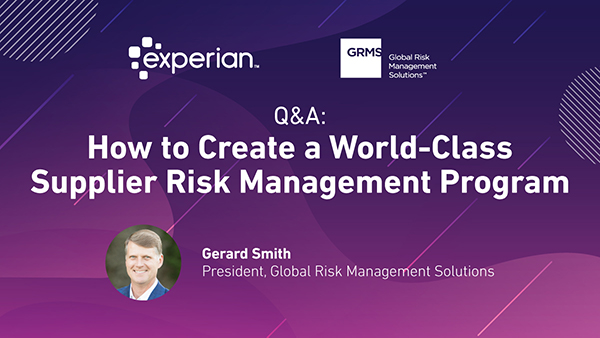
Supplier risk management has become a top priority for procurement and supply chain professionals. With rising regulatory and compliance fines and the global market disruptions caused by trade wars and the pandemic, a robust supplier risk management program is crucial. Gerard Smith, President and Co-founder of Global Risk Management Solutions, shares insights on creating a world-class supplier risk management program. In this interview, discover the essential components and strategies to effectively manage supplier risk and ensure compliance and stability in your supply chain. Evolution of Supplier Risk Management Practices Twenty years ago, when I was in procurement, many organizations self-performed everything. In other words, they collected documents and validated them as best as they could. The issue today is with COVID. With COVID, many companies are concerned. The two things we keep hearing about is the financial stability of the suppliers. Are they financially stable? Not only today, but in the foreseeable future, and secondarily, do they have insurance to protect the client company if there are any errors. So, it's the financials currently, and the insurance companies are most concerned about monitoring. Increasing Complexity in Supplier Risk Management Companies are starting to source globally, and more and more companies are concerned about the supply chain and if there are issues, whether geopolitical or whatever the case may be. So the idea here is to manage supplier risk proactively, and so there are three components of that. First, based on a client's requirements - the ability to do the risk assessment based on specific risk components. Second, having a help desk to try and troubleshoot where there are issues with the suppliers to help them to get into compliance. And third, most importantly, being able to monitor those suppliers for changes in status and getting actual push alerts, to be able to act on those. So, in other words, getting in front of the problem versus finding out that a supplier perhaps filed bankruptcy or showed up on a government watch list or something like that. Key Components of a World-Class Supplier Risk Management Program If a company wishes to have a world-class supplier risk management program, there are five crucial components that you would want to see, they are: Customized Risk Program A Customized Risk Program is tailored to address specific risk components relevant to a company's unique needs. This customization can take various forms: Geographical Considerations: Different regions, such as EMEA (Europe, Middle East, and Africa) and APAC (Asia-Pacific), have distinct regulatory requirements and market conditions. A Customized Risk Program can adapt to these regional differences, ensuring compliance and appropriate risk management practices in each area. Spending Levels: Companies often have both strategic and non-strategic suppliers. Strategic suppliers, with whom the company spends more, may require a more thorough and detailed risk assessment compared to non-strategic suppliers. Customizing the risk program based on spending levels ensures that critical suppliers are monitored more closely. Specific Risk Factors: Different industries and companies face unique risks. Whether it's financial stability, compliance with specific regulations, or reputational risks, a Customized Risk Program can focus on the most relevant risk factors for the company. The key objective of a Customized Risk Program is flexibility. It must be able to adapt to various factors such as geography, spending, and specific risk elements, ensuring it is not a one-size-fits-all solution but rather a bespoke approach to managing supplier risk effectively. Adjudicating Information This involves the critical process of verifying and clarifying data to ensure accuracy. This means systematically identifying and eliminating false positives, which occur when incorrect or irrelevant information is selected. For instance, if you input "Bob's Plumbing" into a database, you might receive numerous results for companies with similar names. The challenge is to determine which "Bob's Plumbing" is the correct one that your company works with. Adjudicating information requires sophisticated methods to accurately select the correct entity and cross-verify the details, ensuring that the data is precise and applicable to your specific supplier. This process is essential for maintaining the integrity and reliability of your supplier risk management program. Reporting In a supplier risk management program, reporting capability is vital for maintaining consistent and measurable compliance standards. This involves generating real-time, standardized reports that provide current risk ratings for all suppliers. With these reports, management can quickly identify which suppliers are in compliance with set standards and which are not, along with the reasons for non-compliance. Additionally, the reports highlight any ongoing issues within the supply chain, enabling management to address problems promptly. Effective reporting ensures transparency, accountability, and the ability to make informed decisions based on up-to-date risk assessments. Document Verification and Monitoring In a supplier risk management program, Document Verification and Monitoring is crucial for ensuring the authenticity and accuracy of the documents submitted by suppliers. While collecting and managing documents can be straightforward, the challenge lies in verifying their validity. Many procure-to-pay, source-to-pay, and ERP platforms face this issue, as they often rely on suppliers to upload documents without proper verification. This can result in the acceptance of invalid or even blank documents. To address this, a robust system or process must be in place to validate key documents such as certificates of insurance, W9 forms, and other critical documentation. This system should not only collect documents but also authenticate them, ensuring they meet the required standards and are current. Continuous monitoring of these documents is essential to maintain compliance and mitigate risks associated with outdated or fraudulent information. By implementing thorough document verification and monitoring, companies can ensure the integrity of their supplier risk management program. Continuous Monitoring Continuous Monitoring refers to the ongoing, real-time oversight of supplier activities and conditions to promptly identify and address potential risks. A primary focus of continuous monitoring is assessing the financial stability of suppliers. This means regularly evaluating their financial health to detect any signs of trouble. If a supplier shows indications of financial distress, such as declining financial metrics or negative market signals, the company can take proactive measures, such as halting purchase orders, to prevent potential disruptions in the supply chain. Continuous monitoring ensures that companies can swiftly respond to changes in a supplier's status, maintaining the reliability and integrity of their supply chain operations. Critical Risk Components for Effective Supplier Risk Management There are eight different risk categories. The risk components that companies should at least address within their program. Financial Stability Financial stability is monitoring financial stability in real-time and be able to identify if there are issues whether they are getting in worse financial shape or perhaps getting in better financial shape. Digital Insurance Verification The best practice right now is what's called digital insurance verification. We're able to manage insurance coverage electronically. We don't even have to collect a certificate of insurance anymore. We can do it digitally in North America. That means that we can monitor a supplier to ensure that they continue to have the insurance requirements daily, which is a unique situation. So you want to make sure, at a minimum, you collect the certificate of insurance. If you want the best practice, you do digital insurance verification. Reputational Protection We do global adverse media monitoring. So as an example, we manage over 25,000 media sources around the globe looking for negative stories because you want to know if your supplier is caught with child labor, or if they've closed a facility somewhere in the world that you're reliant upon. So adverse media is very big at this point because things are evolving very quickly. Regulatory Compliance Regulatory compliance is basically anything that's government regulation. So, it could be the various sanctions lists. Most people don't recognize there are over 1500 watch and sanctions lists around the globe including the U.S OFAC list. That's a big one. It can be a Conflict Minerals Declaration, U.K. Modern Slavery Act, Reach ROHS, the California Transparency Act, anything that's a government regulation falls into that category. Cyber Security Cyber Security would be anything that's involved with data and document verification. It has to be able to collect and validate not only the documents such as a code of conduct, but documents with an expiration date such as an NDA or a diversity certificate. Any standardized documents should be part of the program so suppliers don't get continuously contacted for more documents. Social Responsibility Social responsibility could be anything from diversity verification, child labor, those types of things. Document Management Validate key documents such as certificates of insurance, W9 forms, and other critical documentation. This system should not only collect documents but also authenticate them, ensuring they meet the required standards and are current. Continuous monitoring of these documents is essential to maintain compliance and mitigate risks associated with outdated or fraudulent information. Health and Safety Finally, health and safety could include an HSC questionnaire, EMR ratings, or OSHA statistics. Those are eight areas that companies should at least consider looking into as far as potential risk components. Obviously, there are different parts of each, one of those where those are the broad categories. Global Supplier Risk Assessments: Reliability and Challenges Dependingon what country we're speaking of. Is the information available? Yes, there are varying degrees of information. You can get more information in North American and EMEA than you can say in APAC or South America. Is it available? Absolutely. We can do a supply risk assessment in over 120 countries. So, it is possible to get information. There is standardized information in terms of the adverse media I spoke about. The watch and sanctions list, those are all global. There's a variety of things that can be managed globally. Some of it, in terms of the financial, for instance, it depends on which country we're talking about and how much information can be obtained within that country, and secondarily, whether it can be monitored on an ongoing basis. Again, it depends on which country we're speaking about. In summary Establishing a world-class supplier risk management program involves understanding the evolution of risk management practices, addressing increasing complexities, and incorporating critical components such as financial stability, digital insurance verification, and continuous monitoring. By proactively managing supplier risk, companies can safeguard their supply chain and ensure compliance. Want to go deeper? Watch our on-demand webinar with GRMS If you would like to hear more about GRMS, watch our on-demand webinar Mitigating Supplier Risk in A Changing World." Gerard goes into greater detail on best practices and how you can proactively manage supplier risk management while staying resilient and the new normal.
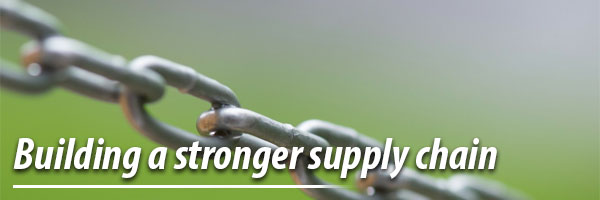
Credit departments have long performed the important role of assessing and monitoring the health of new and existing customer accounts. However, in the wake of the Great Recession and the ensuing slow economic recovery, the need to evaluate the health of supply chain partners has become even more important. In my role here at Experian, I talk to people every day in credit and supply chain management, and I’ve found striking similarities in the roles of both groups. First, each group has an interest in understanding risk when establishing new relationships, whether it be assessing the credit risk of a new customer or determining the financial stability of a critical vendor. Second, both have a shared interest in monitoring the financial health of both customers and vendors (although it could be argued that the potential disruption associated with the loss of a key vendor might carry a much higher impact for a supply chain manager than having to collect on or even charge off a customer account would for someone in credit management.) For example, a major battery supplier for one of the leading electronic vehicle manufacturers ran into financial trouble recently, and it caused all kinds of headaches. The stock price , sales and customers all suffered. The battery company was the sole supplier to this vehicle manufacturer. With proactive credit monitoring, the vehicle manufacturer may have been able to spot signs that the vendor’s financial stability was beginning to deteriorate, and the headaches could’ve been avoided. Thankfully things worked out in the end (the vehicle manufacturer went into the battery production business.) All in the family Business family relationships are also important in credit and supply chain management. Credit professionals would be interested in Corporate Linkage because they really want to know how to manage a particular customer. Understanding if an account is a subsidiary of a parent company that they have an existing relationship with is vital, as it can affect potential opportunities or responsive strategies if they are delinquent. These insights can help make a more informed decision. For example, a credit manager may think twice about aggressively pursuing an account that may even be moderately delinquent if they realize that they also have a sizable relationship with the account’s parent company. By contrast, they might take a firmer approach with a smaller customer who is behind on their payments, but represents a significantly smaller overall spend. On the supply chain side, visibility into the structure of a parent company is also important, because if the parent company runs into financial trouble it’s likely to cause a domino effect that could quickly steamroll into a supply chain crisis. Understanding and monitoring a supplier’s corporate family relationships enables managers to ensure that they truly have adequate supply chain redundancy. As much as Corporate Linkage informs relationship management in credit accounts, it can help the supply chain manager understand how their spend contributes to the suppliers bottom line, creating additional opportunities for spend management. A supply chain manager that knows they are doing business with three subsidiaries of the same company puts them into a much stronger negotiating position when it comes to volume discounts than if they were viewing the businesses as separate suppliers. Industry Groups Focusing Attention One example of an organization paying attention to the converging credit and supply chain management methodologies is Burbank, California-based Credit Management Association, who recently established a Supplier Risk Management Group. Group Facilitator Larry Convoy agrees that credit management is critical to the health of the supply chain saying recently “During my time in credit management, I’ve often heard the following: ‘We can survive if a customer relationship goes bad, but we cannot survive if one of our primary or secondary vendors has an interruption in delivering product, raw materials or services to us.’ For that reason, we invest an equal amount of resources investigating our vendors. We've created an industry credit group based around this idea for our members, as these relationships can make or break their businesses.” Reducing Friction, Increasing Efficiency To take it a step further, credit professionals and supply chain managers are focused on reducing cost and friction, while increasing efficiencies. A client recently said that it takes 15 minutes for an analyst to review the paperwork they require of a new account that does not pass automated vetting, but on average it takes 10 days for the analyst to get the required documentation from the applicant. In some cases, businesses are limited to working with suppliers that are located within their geographical area for logistical reasons. These companies walk a fine line between operational efficiencies and assuming the right amount of risk. If the risk assessment process is too intrusive, the supplier may walk away. Asking for additional information and delays in establishing the account may put a strain on the relationship at the outset, so using third-party data sources in the risk assessment process can help enhance efficiencies and reduce exposure while maintaining a positive supplier relationship. Delinquency vs. Default One difference between credit management and supply chain is that credit departments are typically concerned with predicting customer delinquency and cash flow, while supply chain management tends to be more focused on assessing the risk of supplier default. However, if a supplier plays a critical role in the supply chain, or is not easily replaced, monitoring the supplier’s financial health is vital. It may be the difference between having to shore up a key supplier financially if there begins to be signs of increasingly delinquent payment versus having the supply chain come to a screeching halt if the supplier suddenly fails. Risk Management Trends Many credit management professionals in financial institutions used macro-economic data during the Great Recession to identify potential regional credit trends that could impact the health of their portfolios. This approach may also be valuable to supply chain managers who want to keep regional economic downturns from disrupting their supply chain. It’s smart to assess not just the supplier’s credit, but also how regional credit trends in the supplier’s area may impact the supplier’s financial health. For example, according to Experian , four of the top five metro areas for bankruptcies in the transportation industry are in California. If a company relies heavily on a transportation company in California and that supplier is somewhat dependent on their local market for their ongoing financial wellbeing, it might be wise to have additional transportation suppliers who can provide similar services, but who are headquartered in less economically volatile areas of the country. At the end of the day, there are far more commonalities than differences between credit and supply chain management. Utilizing proven credit risk management tools, and the data that powers them can help reduce weak links in the supply chain and help steer clear of unpleasant surprises. To learn more about Experian risk management solutions contact us at https://www.experian.com/b2b or call 877 565 8153.
